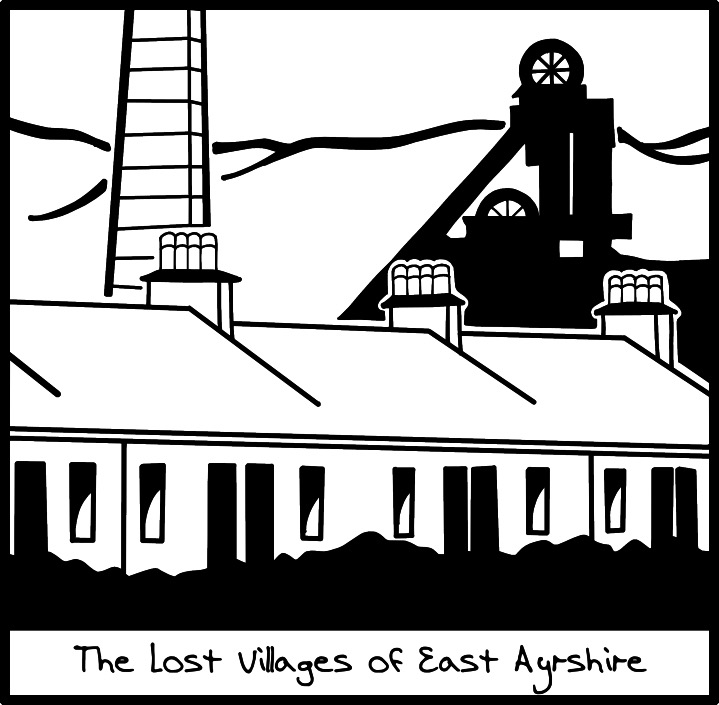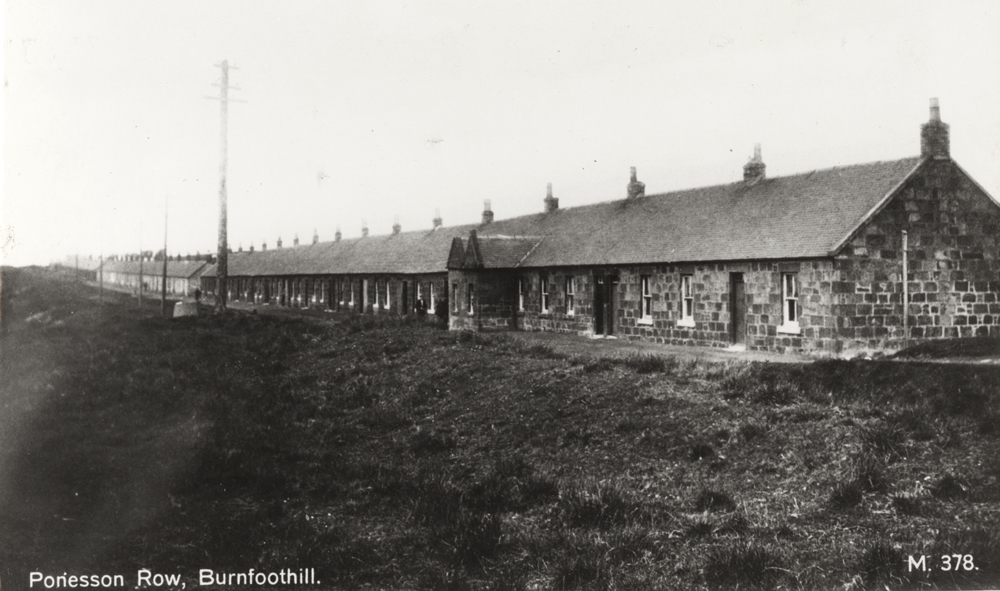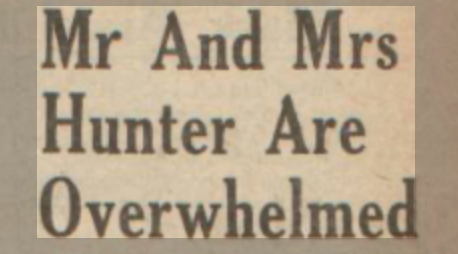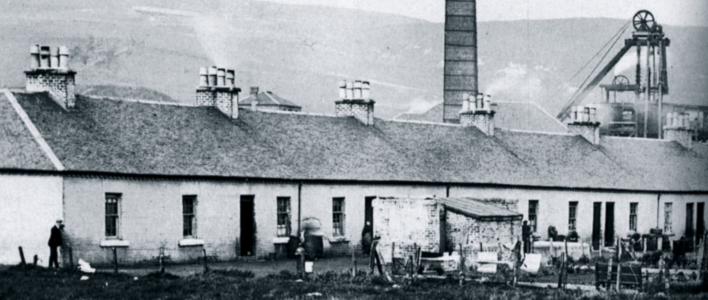We recently had MSc in Historical Studies student, Andrew Pohler, join the Lost Villages on a work placement. Andrew looked at the coverage of mining accidents in our villages in the newspapers.

In a brief article directed to the Editor of the Glasgow Sentinel in 1858, an anonymous writer would remark that:
‘there is a laxity, from some cause or other, in the reports of severe accidents and deaths in coal mines… in finding their way to the public journals’.
The writer implied that such reports would be detrimental to the reputation of the owners and employers, with the result that ‘half of the pit accidents are concealed’. In defence of this position, a major accident that occurred in the Round Pit in Darnconner was cited, which still had not been reported to the press weeks later. The writer would lament that ‘Men may be burned, and die, and the public know nothing of it’.[i] This oversight (whether deliberate or not) would gradually begin to disappear over the next century, but it is quite illustrative of the challenge faced in gathering material on the working lives and community of the villagers of the ‘Lost Villages’ within contemporary newspapers, as they were not widely reported on until the early 20th century onwards.
An added complication to this dearth of material is the relative obscurity of both the villages themselves and the names and language used to identify them. As part of a daily gossip column in the Daily Record, a visitor to Lethanhill noted that while locals called the village Lethanhill – with an ‘ill-defined portion’ designated as Burnfoothill – it was named Dunaskin by the Post Office. For those undertaking a visit, they would have to ask for a ticket to Patna or Waterside depending on the mode of public transport used.[ii] Such a varied range of terminology ably conveys the difficulty in finding records on the so-called ‘Lost Villages’, and may hint that there is far more material to find, if only the correct search terms are found.

IMAGE: Ponessan Row, Burnfoothill from East Ayrshire Council Archives
As for the accounts of mining deaths and accidents found in contemporary newspapers, statistically speaking, no noticeable patterns relating to age emerge in the articles that were found dealing with mining injuries and accidents in contemporary newspapers. It is important to note however that these reports would often omit details such as the age or manner of accident, due to their extreme brevity. Injuries and deaths were common to all age groups, and a wide range of ages from 17 to 65 were represented in the reports. When looking at the type of accidents themselves, there are those that reoccur with far more frequency than others. By far the most common in these accounts were those involving a fall – of stone, coal, or the roof itself collapsing, often resulting in fatalities. Other commonly reported accidents involved explosions, burning incidents, injuries sustained due to runaway coal hutches, or the collapse of scaffolding and incidents on the railways.
What becomes immediately striking in examining these contemporary reports is the relative sparseness of detail allotted to covering them. Indeed, a section on a calamitous death would often be an unassuming sentence or two in a corner of the page, overshadowed by large, striking advertisements or much larger headlines. It is exactly this lack of detail that invites further thought on the devastating consequences such accidents could have on the families of the villages, constituting as they did frequent occurrences in the occupation. One particularly illustrative and affecting example are the deaths of 20-year-old William G. M’Connachie and 47-year-old William M’Connachie, occurring five years apart and reported in different newspapers. Both are surmised to have been family members as they lived in the same location at 138 Lethanhill, and this is one of many examples of a family losing several members within a short space of time.[iii] Another example in the Evening Times in 1919 records the death of Hector Jones, 17 years old, who was ‘working as a drawer with his father and brother’.[iv] This is a particularly devastating example where the miners were impotent witnesses to the unpredictable and sudden deaths of family members they were engaged in work with, such groups being a common practice.

Image: ‘They’re All So Proud Of Benwhat!’, July 4. 1948, Sunday Post. p.5 © D.C.Thomson & Co. Ltd. Image created courtesy of THE BRITISH LIBRARY BOARD., British Newspaper Archive.
As to the way in which the working miners and their families responded to the ever-present danger facing them in their employment, detail is again sparse, but several recurring themes become apparent in the articles available. In some of the villages, there was an observable pride in the work undertaken, as in the case of Benwhat, who won two prizes for the ‘best-kept pithead’, the village being noted as ‘one of Scotland’s most picturesque villages’.[v] Another inquiry in the Scotsman in 1919 into the housing conditions in the villages examined Burnfoothill in detail, noting that it represented an ‘oasis’ among those examples examined, featuring a high standard of cleanliness among the community, well-tended gardens, and clean and tidy cottages despite being ‘little better-off in stone and lime’ or the provision of necessary amenities.[vi]

Image: ‘Mr and Mrs Hunter Are Overwhelmed’, March, 27. 1949, Sunday Post, p.9. © D.C.Thomson & Co. Ltd. Image created courtesy of THE BRITISH LIBRARY BOARD. British Newspaper Archive.
One of the major themes that is particularly striking is the strong community spirit and the sense of communal support networks within the villages of Ayrshire under consideration. In the event of debilitating injury or disaster facing a worker and his family, the tendency was for the other inhabitants to contribute whatever they could spare to ensure their survival until they could resume work. This is most apparent in the case of Jimmy Hunter, as described in the Sunday Post in March 1949, who due to injuries sustained from collapsing scaffolding was out of work for several months, recovering in hospital. On his return, his family was struck by a further tragedy as their prefab house burned down in an accident. Surrounding villages were instrumental in giving them the necessary support to furnish their new home (granted through the efforts of the County Councillor) with linen, furniture, and other supplies, with Auchinleck and Benwhat being particularly noteworthy.[vii]

Image: ‘Ayrshire Miner Honoured for Bravery’, Oct, 15. 1938, The Scotsman, p.20. © Johnston Press plc, British Newspaper Archive.
There are also multiple accounts of miners acting with great selflessness and bravery during ongoing accidents, as in the case at the Pennyvenie mine of Dalmellington in November 1932. One Thomas Ballantyne of 175 Lethanhill rescued a fellow worker by shouting a warning after seeing the roof moving, and preventing another fall by diverting falling stones from the injured man’s head with his own body, which led to him receiving a certificate from the Carnegie Hero Trust and £10 monetary award for his act.[viii] Indeed, in the report on another incident several years later, Inspector Douglas of the Ayrshire Constabulary noted that ‘in time of need the miner was always ready to brave danger for a companion’, a trait which is apparent in many of the articles[ix].
It was exactly this communal spirit that was threatened by the ongoing relocation of the village populations to the new housing schemes. In the aforementioned article on Benwhat, it was remarked that ‘Old associations are being broken’ in the condemned houses and subsequent rehousing projects.[x] Another article noted that there were concerns over the diminishment of the ‘good fellowship and friendliness’ intrinsic to the village in the new housing scheme at Bellsbank, as there was little chance for the ‘continuity of the communal life which was a feature at Benwhat’.[xi] In this sense, another casualty (for some villages) of rapid deindustrialisation and rehousing projects was the impact it had on the community bonds that were so essential in providing networks of support for those labouring in an undertaking which was characterised by gruelling conditions and perennial danger.
[i] To the Editor of the Glasgow Sentinel, June, 05. 1858. Glasgow Sentinel, p6. British Newspaper Archive
[ii] The Lost Village, Jan, 27. 1939. The Daily Record. P.11. British Newspaper Archive
[iii] Feb, 22. 1934. Edinburgh Evening News. P.2. and Colliery Deaths Inquiry, Jun, 13. 1939. Daily Record. P.28, British Newspaper Archive
[iv] Pit Fatality at Dunaskin, Nov, 5. 1919. Evening Times. Accessed at: http://www.scottishmining.co.uk/333.html
[v] They’re All So Proud Of Benwhat!, July 4. 1948. Sunday Post P.5, British Newspaper Archive
[vi] Mar, 18. 1919. The Scotsman. P.4. British Newspaper Archive
[vii] Mr and Mrs Hunter Are Overwhelmed, March, 27. 1949. Sunday Post. P.9. British Newspaper Archive
[viii] Inverness Rescue, Feb, 24. 1933. Dundee Courier. P.5. British Newspaper Archive
[ix] Ayrshire Miner Honoured for Bravery, Oct, 15. 1938. The Scotsman. P.20. British Newspaper Archive
[x] They’re All So Proud Of Benwhat!, July 4. 1948. Sunday Post P.5, British Newspaper Archive
[xi] Community Centre Wanted, Feb, 9. 1951. Kilmarnock Herald and North Ayrshire Gazette. P.6. British Newspaper Archive
